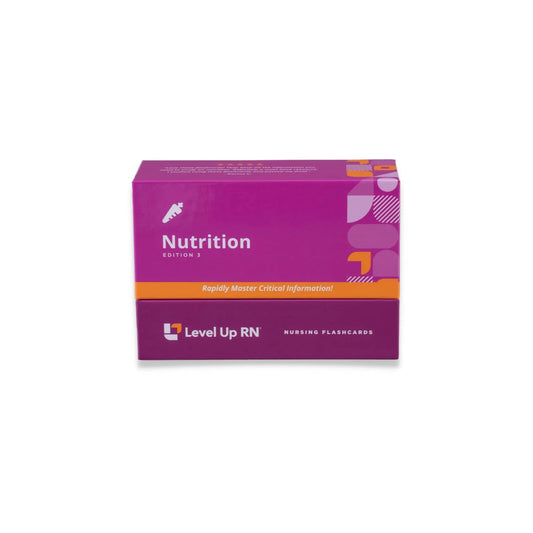Hi, I'm Cathy with Level Up RN. In this video, I will be discussing enteral nutrition. And at the end of the video, I'm going to give you guys a quiz to test your understanding of some of the key points I'll be covering. So definitely stay tuned for that. And if you have our Level Up RN, Nutrition Flashcards, go ahead and pull out your flashcards so you can follow along with me and pay close attention to the bold red text on the back of the cards because those are the things that you are likely to get tested on in nursing school.
Enteral nutrition is a method of feeding where nutrients are delivered to the patient via the gastrointestinal tract, so either by mouth or feeding tube. Whereas parenteral nutrition is where nutrients are delivered to the patient through an IV, so outside the GI tract. So in this video, we'll be talking about enteral nutrition. And in the next video in this playlist, I will talk about parenteral nutrition.
Indications for a feeding tube include disorders that cause dysphagia, which is difficulty swallowing, such as Parkinson's disease. Other indications include an upper GI obstruction, malnutrition, and severe anorexia nervosa, just to name a few. And then a patient who is in a coma would also receive tube feeding. If a patient only requires short-term enteral nutrition, then something like a nasogastric tube can be used to deliver nutrients. However, if the patient requires long-term enteral nutrition, so over four weeks, then they will require placement of a gastrostomy tube, which is a tube that passes through the abdominal wall into the gastric cavity. This tube is often placed in a procedure called percutaneous endoscopic gastrostomy, or a PEG procedure. And the tube placed in this procedure is referred to as a PEG tube. A patient with a feeding tube may receive continuous feeding, which can be delivered via gravity or using a pump. The patient may also receive intermittent feedings, which can be delivered via gravity, with a pump, or delivered as a bolus using a syringe. When initiating tube feeding for your patient, it's important to follow your facility's policy, which will likely have you slowly increasing the feeding rate until the ordered rate is achieved. And this helps to improve the patient's tolerance to tube feeding.
Before administering a tube feeding, you need to perform an abdominal assessment and confirm the presence of bowel sounds. You also need to keep the head of the bed between 30 and 45 degrees during the feeding and for at least one hour after the feeding in order to prevent aspiration, which is where food goes down into the airways as opposed to the stomach. Confirming placement of the tube is also essential. So after the tube is initially placed, placement needs to be confirmed with an X-ray. And you better believe you're going to be asked about that on a nursing school exam. Ongoing, placement can be confirmed by aspirating some of the gastric contents and measuring the pH, which should be under 5.5.
Of note, it is not best practice to confirm placement of the tube by instilling air into the tube while listening to the patient's abdomen with your stethoscope. Before each feeding, you also want to aspirate the patient's gastric contents with a syringe and measure the gastric residual volume, or GRV. And then you need to follow your facility's policy as to whether the next feeding should be held if the patient has a large GRV and whether that volume should be returned to the stomach.
And then in terms of flushing the tube, you should flush the tube with 30 milliliters of water before and after feeding, before and after medication administration, after doing your gastric residual check, and every four hours during continuous feeding. You should change the bag and tubing every 24 hours or per facility policy. And then in order to prevent bacterial growth, you want to limit the hang time of the formula per the manufacturer guidelines. This is often four hours for open systems, which is where you pour formula into a feeding bag, or it can be between 24 and 48 hours for closed systems, which is where you have a pre-filled container that you spike with tubing.
All right. It's quiz time. Are you guys ready?
Question number 1. How should initial placement of a feeding tube be confirmed?
The answer is with an X-ray.
Question number 2. After confirming initial placement, how should tube placement be confirmed ongoing?
The answer is by checking the pH of the aspirated contents.
Question number 3. Why is the head of the bed kept between 30 and 45 degrees during a feeding and for one hour afterwards?
The answer is to decrease the risk of aspiration.
All right. That's it for this video. Thank you so much for watching, and good luck with studying.


